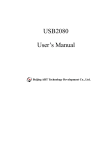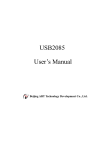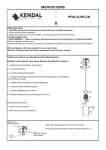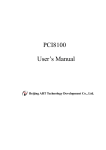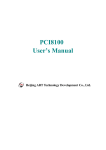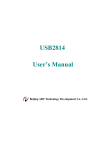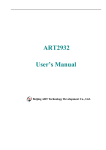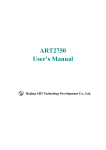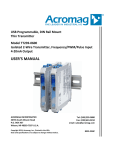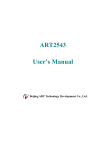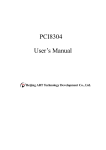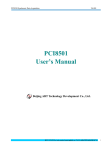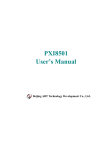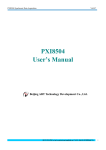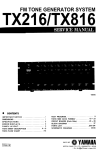Download ART2768 User`s Manual
Transcript
ART2768 User’s Manual Beijing ART Technology Development Co., Ltd. Beijing ART Technology Development Co., Ltd. V6.051 Contents Contents ................................................................................................................................................................................2 Chapter 1 Overview ..............................................................................................................................................................3 Chapter 2 Components Layout Diagram and a Brief Description .......................................................................................5 2.1 The Main Component Layout Diagram ..................................................................................................................5 2.2 The Function Description for the Main Component ...............................................................................................5 2.2.1 Signal Input and Output Connectors ............................................................................................................5 2.2.2 Potentiometer ...............................................................................................................................................6 2.2.3 Jumper..........................................................................................................................................................6 2.2.4 Board Base Address Selection .....................................................................................................................6 2.2.5 Indicator .......................................................................................................................................................9 Chapter 3 Signal Connectors...............................................................................................................................................10 3.1 Analog Input/Output Interface ..............................................................................................................................10 3.2 Analog Signal Connector ......................................................................................................................................10 3.3 Digital Input/Output Connector ............................................................................................................................10 Chapter 4 Connection Ways for Input and Output..............................................................................................................12 4.1 Analog Output Connection....................................................................................................................................12 4.2 External Trigger Signal (ART) Connection ..........................................................................................................12 4.3 Clock input/Output and Digital Trigger Signal Connection..................................................................................12 4.4 Digital Signal Input Connection............................................................................................................................13 4.5 Digital Signal Output Connection.........................................................................................................................13 4.6 Methods of Realizing the Multi-card Synchronization .........................................................................................14 Chapter 5 The Instruction of the DA Trigger Function.......................................................................................................16 5.1 DA Internal Trigger Mode.....................................................................................................................................16 5.2 DA External Trigger Mode....................................................................................................................................16 5.2.1 ATR Trigger................................................................................................................................................16 5.2.2 DTR Trigger...............................................................................................................................................17 Chapter 6 Methods of using Internal and External Clock Function...................................................................................19 6.1 Internal Clock Function ........................................................................................................................................19 6.2 External Clock Function .......................................................................................................................................19 Chapter 7 Address Allocation Table....................................................................................................................................20 Chapter 8 Notes and Warranty Policy ................................................................................................................................23 8.1 Notes .....................................................................................................................................................................23 8.2 Analog Signal Output Calibration.........................................................................................................................23 8.3 Warranty Policy.....................................................................................................................................................23 Products Rapid Installation and Self-check ........................................................................................................................25 Rapid Installation ........................................................................................................................................................25 Self-check ...................................................................................................................................................................25 Delete Wrong Installation ...........................................................................................................................................25 BUY ONLINE at art-control.com/englishs or CALL+86-10-62991792-609(CN) 2 Beijing ART Technology Development Co., Ltd. V6.051 Chapter 1 Overview ART2768 is an arbitrary waveform generator card based on PC104 bus, can be connected to the computer's PC104 interface to constitute the laboratory, product quality inspection center and other areas of data acquisition, waveform analysis and processing system. And also can constitute industrial process monitoring system. Its main applications are: ■ Electronic Product Quality Testing ■ Signal acquisition ■ Process Control ■ Servo Control Unpacking Checklist Check the shipping carton for any damage. If the shipping carton and contents are damaged, notify the local dealer or sales for a replacement. Retain the shipping carton and packing material for inspection by the dealer. Check for the following items in the package. If there are any missing items, contact your local dealer or sales. ¾ Art2768 Data Acquisition Board ¾ ART Disk a) user’s manual (pdf) b) drive c) catalog ¾ Warranty Card DA Arbitrary Waveform Output Function ¾ ¾ ¾ ¾ ¾ ¾ ¾ ¾ ¾ ¾ ¾ ¾ ¾ ¾ ¾ ¾ Converter Type: DAC7641 Output Range: 0~5V, 0~10V, ±5V, ±10V Resolution: 16-bit Output Point Rate (Frequency): up to 1MHz (1us/point). software adjustable, adjustable range: 0.01Hz ~ 1MHz Number of Channels: 4 Trigger Source : software trigger source, hardware analog trigger source (ATR), hardware digital trigger source (DTR) Trigger Level: 0 ~ 10V Trigger Direction (TriggerDir): negative trigger, positive trigger, either positive or negative trigger Clock Source: internal clock and external (software selectable) Memory Depth: each channel is 256K word (point) RAM Memory Data Transmission: program mode DA Set-up Time: 10μs (0.003% accuracy) Non-linear Error: ±3LSB (maximum) Output error (full-scale): ±2LSB Operating Temperature Range: 0℃~ +50℃ Storage Temperature Range: - 20℃~ +70℃ BUY ONLINE at art-control.com/englishs or CALL+86-10-62991792-609(CN) 3 Beijing ART Technology Development Co., Ltd. V6.051 Digital Input ¾ ¾ ¾ ¾ Channel No.: 4-channel Electric Standard: TTL compatible High Voltage: ≧2V Low Voltage: ≦0.8V Digital Output ¾ ¾ ¾ ¾ ¾ Channel No.: 4-channel Electrical Standard: TTL compatible High Voltage: ≧3.8V Low Voltage: ≦0.44V Power-on Reset Other Features ¾ ¾ On-board Clock Oscillator: 40MHz Dimension: 102mm (L) * 127mm (W) * 16mm (H) BUY ONLINE at art-control.com/englishs or CALL+86-10-62991792-609(CN) 4 Beijing ART Technology Development Co., Ltd. V6.051 Chapter 2 Components Layout Diagram and a Brief Description 2.1 The Main Component Layout Diagram 2.2 The Function Description for the Main Component 2.2.1 Signal Input and Output Connectors P1: Analog signal output connector P2: Digital signal input/output connector AO0: Analog output interface AO1: Analog output interface AO2: Analog output interface AO3: Analog output interface ATR: Analog trigger signal input interface BUY ONLINE at art-control.com/englishs or CALL+86-10-62991792-609(CN) 5 Beijing ART Technology Development Co., Ltd. V6.051 2.2.2 Potentiometer RP1: AO0 analog output zero-point adjustment RP2: AO0 analog output full-scale adjustment RP3: AO1 analog output zero-point adjustment RP4: AO1 analog output full-scale adjustment RP5: AO2 analog output zero-point adjustment RP6: AO2 analog output full-scale adjustment RP7: AO3 analog output zero-point adjustment RP8: AO3 analog output full-scale adjustment RP9: ATR trigger level adjustment 2.2.3 Jumper JP1, JP2, JP3, JP4: AO0 ~ AO3 analog output signal reset selection, when the 2-3 pins of the jumpers corresponding to the channels are shorted, the range reset to the 0 code value (0x000), when 1-2 pins are shorted, reset to the middle code value of the range (0x800). Corresponds to the DA range, the reset value selection as follows: JP1, JP2, JP3, JP4 0~5V 0~10V ±5V ±10V 0V 0V -5V -10V 2.5V 5V 0V 0V PIRQ, PDRQ: reserved 2.2.4 Board Base Address Selection ADDR1: board base address DIP switches. Board base address can be set to binary code which from 200H to 3F0H be divided by 16, board base address defaults 300H, will occupy the base address of the date of 44 consecutive I/O addresses. Switch No. 3, 4, 5, 6, 7, 8 correspond to address bits A4, A5, A6, A7, A8, A9 are the base address of selector switch, Switch No.1, 2 are reserved bits. Board base address selection is as follows: when the ADDR1 switches dial to "ON" that means the high virtual is 1, the switch to the other side means the low virtual value is 0. Base address configuration methods Address bit A11 A10 A9 A8 A7 A6 A5 A4 A3 A2 A1 A0 X is configurable bit unused unused x x x x x x x 0 0 0 The third hex bits The second hex bits The first hex bits Note: in the table, the bit which is labeled "0"is a fixed value, only the bit that labeled "x" can be changed by the ADDR1. BUY ONLINE at art-control.com/englishs or CALL+86-10-62991792-609(CN) 6 Beijing ART Technology Development Co., Ltd. V6.051 For example, the default base addresses is300H, A8, A9= "ON", shown as the following: A9 A8 A7 A6 A5 A4 A3 A2 8 7 6 5 4 3 2 1 ADDR1 ON Common base address Adr 200H ADDR1 Adr A9 A8 A7 A6 A5 A4 A3 A2 8 7 6 5 4 3 2 1 210H ADDR1 ON ON 220H A4 A3 A2 8 7 6 5 4 3 2 1 ADDR1 ON ON A6 A5 A4 A3 A2 A9 A8 A7 A6 A5 A4 A3 A2 6 5 4 3 2 1 8 7 6 5 4 3 2 1 230H ON A9 A8 A7 A6 A5 A4 A3 A2 8 7 6 5 4 3 2 1 ADDR1 ON ON 250H ADDR1 ON A9 A8 A7 A6 A5 A4 A3 A2 8 7 6 5 4 3 2 1 ADDR1 ON ON A9 A8 A7 A6 A5 A4 A3 A2 A9 A8 A7 A6 A5 A4 A3 A2 8 7 6 5 4 3 2 1 8 7 6 5 4 3 2 1 270H ADDR1 ON ADDR1 ON ON A9 A8 A7 A6 A5 A4 A3 A2 A9 A8 A7 A6 A5 A4 A3 A2 8 7 6 5 4 3 2 1 8 7 6 5 4 3 2 1 290H ON ON A9 A8 A7 A6 A5 A4 A3 A2 8 7 6 5 4 3 2 1 ON ON ADDR1 ON ON 2B0H ADDR1 A9 A8 A7 A6 A5 A4 A3 A2 8 7 6 5 4 3 2 1 ADDR1 ON ON A9 A8 A7 A6 A5 A4 A3 A2 A9 A8 A7 A6 A5 A4 A3 A2 8 7 6 5 4 3 2 1 8 7 6 5 4 3 2 1 2D0H ADDR1 ON A5 A7 ADDR1 2C0H A6 7 ON 2A0H A7 A8 ADDR1 280H A8 8 ON 260H A9 A9 ON 240H ADDR1 ON ADDR1 ON BUY ONLINE at art-control.com/englishs or CALL+86-10-62991792-609(CN) ON 7 Beijing ART Technology Development Co., Ltd. 2E0H V6.051 A9 A8 A7 A6 A5 A4 A3 A2 A9 A8 A7 A6 A5 A4 A3 A2 8 7 6 5 4 3 2 1 8 7 6 5 4 3 2 1 2F0H ADDR1 ON ON 300H A9 A8 A7 A6 A5 A4 A3 A2 8 7 6 5 4 3 2 1 ON ON 320H A3 A2 8 7 6 5 4 3 2 1 ADDR1 ON ON A6 A5 A4 A3 A2 A9 A8 A7 A6 A5 A4 A3 A2 5 4 3 2 1 8 7 6 5 4 3 2 1 330H ADDR1 ON ADDR1 ON ON A9 A8 A7 A6 A5 A4 A3 A2 A9 A8 A7 A6 A5 A4 A3 A2 8 7 6 5 4 3 2 1 8 7 6 5 4 3 2 1 350H ADDR1 ON A9 A8 A7 A6 A5 A4 A3 A2 8 7 6 5 4 3 2 1 ADDR1 ON ON 370H ADDR1 ON A9 A8 A7 A6 A5 A4 A3 A2 8 7 6 5 4 3 2 1 ADDR1 ON ON A9 A8 A7 A6 A5 A4 A3 A2 A9 A8 A7 A6 A5 A4 A3 A2 8 7 6 5 4 3 2 1 8 7 6 5 4 3 2 1 390H ADDR1 ON A9 A8 A7 A6 A5 A4 A3 A2 8 7 6 5 4 3 2 1 ON A9 A8 A7 A6 A5 A4 A3 A2 8 7 6 5 4 3 2 1 ON A9 A8 A7 A6 A5 A4 A3 A2 8 7 6 5 4 3 2 1 ADDR1 ON ON 3D0H ADDR1 ADDR1 ON 3B0H ADDR1 ON A9 A8 A7 A6 A5 A4 A3 A2 8 7 6 5 4 3 2 1 ADDR1 ON ON A9 A8 A7 A6 A5 A4 A3 A2 A9 A8 A7 A6 A5 A4 A3 A2 8 7 6 5 4 3 2 1 8 7 6 5 4 3 2 1 3F0H ADDR1 ON A4 6 ON 3E0H A5 A7 ON 3C0H A6 7 ON 3A0H A7 A8 ON 380H A8 8 ON 360H A9 A9 ON 340H ON ON 310H ADDR1 ADDR1 ON ADDR1 ON BUY ONLINE at art-control.com/englishs or CALL+86-10-62991792-609(CN) ON 8 Beijing ART Technology Development Co., Ltd. V6.051 2.2.5 Indicator +5 VA: +5V analog power indicator +5 VD: +5V digital power indicator +3.3 VD: +3.3V digital power indicator RAM3: AO3 analog output channel RAM status indicator RAM2: AO2 analog output channel RAM status indicator RAM1: AO1 analog output channel RAM status indicator RAM0: AO0 analog output channel RAM status indicator BUY ONLINE at art-control.com/englishs or CALL+86-10-62991792-609(CN) 9 Beijing ART Technology Development Co., Ltd. V6.051 Chapter 3 Signal Connectors 3.1 Analog Input/Output Interface ART2768 has five signal interface, AO0, AO1, AO2, AO3, and ATR signal port, AO0, AO1, AO2, AO3 are analog output ports of the 4 channels DA, corresponding to the AO0 ~ AO3 pins of the P1, ATR is analog trigger signal input port, corresponding to the ATR pin of the P1. 3.2 Analog Signal Connector P1: 10-pin definition AGND 10 9 ATR AGND 8 7 AO3 AGND 6 5 AO2 AGND 4 3 AO1 AGND 2 1 AO0 Pin definition Signal Name Type Definition AO0~AO3 Output Analog output pins ATR Input Analog trigger signal input port AGND GND Analog ground 3.3 Digital Input/Output Connector P2: 20-pin definition +5V 1 2 +5V DI0 3 4 DI1 DI2 5 6 DI3 DO0 7 DO1 DO2 9 8 10 DGND 11 12 DGND CLKOUT 13 CLKIN 15 14 DGND 16 DGND DTR 17 18 DGND DGND 19 20 DGND DO3 BUY ONLINE at art-control.com/englishs or CALL+86-10-62991792-609(CN) 10 Beijing ART Technology Development Co., Ltd. V6.051 Pin definition Signal Name Type Definition CLKIN Input External clock input pin CLKOUT Output Internal clock output pin DTR Input External digital trigger signal input pin +5V PWR +5V power output pin DGND GND Digital ground NC NC BUY ONLINE at art-control.com/englishs or CALL+86-10-62991792-609(CN) 11 Beijing ART Technology Development Co., Ltd. V6.051 Chapter 4 Connection Ways for Input and Output 4.1 Analog Output Connection 4.2 External Trigger Signal (ART) Connection 4.3 Clock input/Output and Digital Trigger Signal Connection BUY ONLINE at art-control.com/englishs or CALL+86-10-62991792-609(CN) 12 Beijing ART Technology Development Co., Ltd. V6.051 4.4 Digital Signal Input Connection 4.5 Digital Signal Output Connection DO0 switch signal DO1 DO2 DO3 switch device switch device DGND BUY ONLINE at art-control.com/englishs or CALL+86-10-62991792-609(CN) 13 Beijing ART Technology Development Co., Ltd. V6.051 4.6 Methods of Realizing the Multi-card Synchronization Three methods can realize the synchronization for the ART2768, the first method is using the cascade master-slave card, the second one is using the common external trigger, and the last one is using the common external clock. When using master-slave cascade card programs, the master card generally uses the internal clock source model, while the slave card uses the external clock source mode. After the master card and the slave card are initialized according to the corresponding clock source mode. At first, start all the slave cards, as the main card has not been activated and there is no output clock signal, so the slave card enters the wait state until the main card was activated. At this moment, the multi-card synchronization has been realized. When you need to sample more than channels of a card, you could consider using the multi-card cascaded model to expand the number of channels. When using the common external trigger, please make sure all parameters of different ART2768 are the same. At first, configure hardware parameters, and use analog or digital signal triggering (ATR or DTR), then connect the signal that will be sampled by ART2768, input triggering signal from ART pin or DTR pin, then click “Start Sampling” button, at this time, ART2768 does not sample any signal but waits for external trigger signal. When each module is waiting for external trigger signal, use the common external trigger signal to startup modules, at last, we can realize synchronization data acquisition in this way. See the following figure: External Trigger Signal ATR/DTR ART2768 ATR/DTR ART2768 ATR/DTR ART2768 When using the common external clock trigger, please make sure all parameters of different ART2768 are the same. At first, configure hardware parameters, and use external clock, then connect the signal that will be sampled by ART2768, input trigger signal from ART pin or DTR pin, then click “Start Sampling” button, at this time, ART2768 does not sample any signal, but wait for external clock signal. When each module is waiting for external clock signal, use the BUY ONLINE at art-control.com/englishs or CALL+86-10-62991792-609(CN) 14 Beijing ART Technology Development Co., Ltd. V6.051 common external clock signal to startup modules, at last, we realize synchronization data acquisition in this way. See the following figure: BUY ONLINE at art-control.com/englishs or CALL+86-10-62991792-609(CN) 15 Beijing ART Technology Development Co., Ltd. V6.051 Chapter 5 The Instruction of the DA Trigger Function 5.1 DA Internal Trigger Mode When DA is in the initialization, if the DA hardware parameter DAPara. TriggerSource= ART2768_TRIGMODE_SOFT, we can achieve the internal trigger acquisition. In this function, calling the InitDeviceDA function to initial the device, then wait EnableDeviceDA function to start DA, DA immediately access to the conversion process and not wait for the conditions of any other external hardware. It also can be interpreted as the software trigger. As for the specific process, please see the figure below, the cycle of the DA work pulse is decided by the sampling frequency. Start Pulse Trigger Level The first working pulse after the DA start pulse Figure 5.1 Internal Trigger Mode 5.2 DA External Trigger Mode When DA is in the initialization, if the DA hardware parameter DAPara. TriggerSource= ART2768_TRIGSRC_ATR, we can achieve the ATR trigger acquisition, if DAPara. TriggerSource=ART2768_TRIGSRC_DTR, we can achieve the DTR trigger acquisition. In this function, calling theInitDeviceDA function to initial the device, then wait EnableDeviceDA function to start DA, DA will not immediately access to the conversion process but wait for the external trigger source signals accord with the condition, then start converting the data. It also can be interpreted as the hardware trigger. Trigger source includes the DTR (Digital Trigger Source) and ATR (Analog Trigger Source). 5.2.1 ATR Trigger Analog trigger source uses the analog signal which can change in a certain range. The trigger source signal provided by the ATR and the analog trigger level are into the comparator simultaneously, and the do high-speed analog comparison in the comparator, generate a comparison expected result (Result) to trigger DA (see below). Analog trigger signal decided by the voltage that output by the serial D/A. The analog trigger source signal effective range is LVTTL, it can be achieved through the computer writes the serial number to the D/A, the software function is SetDevTrigLevelDA (). BUY ONLINE at art-control.com/englishs or CALL+86-10-62991792-609(CN) 16 Beijing ART Technology Development Co., Ltd. V6.051 ATR Serial Number D/A DAOUT Comparator Result Figure 5.2 Analog Comparator When DAPara. TriggerDir = ART2768_TRIGDIR_POSITIVE, it is positive trigger, that is, when ATR trigger source signal changes from smaller than trigger level to higher than trigger level, DA immediately into the conversion process, in this case, its follow-up changes have no effect on DA acquisition, unless the user re-initialize the AD. When DAPara. TriggerDir = ART2768_TRIGDIR_NEGATIVE, it is negative trigger, it is triggered in the opposite direction with the positive, but the others are the same as the positive trigger. See the Figure 5.3: DA Start Pulse The first pulse after DA Working Pulse the DA triggered Trigger Signal Trigger Level The waiting time The falling edge before The first falling edge after the the DA started is invalid AD started is valid Figure5.3 Falling Edge Trigger When DAPara.TriggerDir = ART2768_TRIGDIR_POSIT_NEGAT, choose the trigger mode as rising or falling edge trigger. As long as the trigger sources signal across the trigger level, it will trigger DA immediately. The follow-up changes have no effect on DA acquisition. This function can be used in the case that the acquisition will occur if the exoteric signal changes. 5.2.2 DTR Trigger DAPara.TriggerDir = ART2768_TRIGDIR_NEGATIVE, that is negative trigger. When the trigger signal changes from the high-level to low-level (falling edge signal), it will generate a trigger event, DA immediately into the conversion process, and its follow-up changes have no effect on DA acquisition. BUY ONLINE at art-control.com/englishs or CALL+86-10-62991792-609(CN) 17 Beijing ART Technology Development Co., Ltd. V6.051 DA Start Pulse Digital Trigger Signal The falling edge before The waiting time The first falling edge after the the DA started is invalid DA started is valid The DA Working Pulse first working pulse after triggered Figure5.4 Falling Edge Trigger DAPara.TriggerDir = ART2768_TRIGDIR_ POSITIVE, that is positive trigger. When the trigger signal changes from the low-level to high-level (rising edge signal), it will generate a trigger event, DA immediately into the conversion process, and its follow-up changes have no effect on DA acquisition. When ADPara.TriggerDir = ART2768_TRIGDIR_POSIT_NEGAT, choose the trigger mode as rising or falling edge trigger. As long as the trigger sources signal appear high-level or low-level (rising edge or falling edge), it will trigger DA immediately. The follow-up changes have no effect on DA acquisition. This function can be used in the case that the acquisition will occur if the exoteric signal changes. BUY ONLINE at art-control.com/englishs or CALL+86-10-62991792-609(CN) 18 Beijing ART Technology Development Co., Ltd. V6.051 Chapter 6 Methods of using Internal and External Clock Function 6.1 Internal Clock Function Internal clock function use the clock signal that generated by the on-board clock oscillator to trigger DA conversion (ie, DA refresh clock). The clock of the waveform data that stored in the RAM is generated on-board logic control circuit, and according to the user specified frequency divided by the number, the max clock is the same as the trigger DA frequency, the min clock is the 65535 times of the DA trigger frequency, in this case, we can achieve slow playback the waveform in the RAM. To use the internal clock function, the hardware parameters DAPara.ClockSouce =ART2768_CLOCKSRC_IN should be installed in the software. The frequency of the clock in the software depends on the hardware parameters DAPara.Frequency. For example, if Frequency = 100000, that means the speed of read waveform is 100KHz, but the DA's refresh clock unchanged , it is still 40MHz. 6.2 External Clock Function External clock function uses the external clock signal to trigger the DA. The clock signal is provided by the CLKIN pin. To use the external clock function, the hardware parameters DAPara.ClockSouce = ART2768_CLOCKSRC_OUT should be installed in the software. The clock frequency depends on the external clock frequency. In external clock mode, both the read waveform data clock and DA refresh frequency are the same as external. BUY ONLINE at art-control.com/englishs or CALL+86-10-62991792-609(CN) 19 Beijing ART Technology Development Co., Ltd. V6.051 Chapter 7 Address Allocation Table ART2768 register address as follows: Base address +0 x0 Base address+0x2 write data write control address Base address+0x2 read data 0x0000 Read back DA0_MODE control word, the low 7-bit effective 0x0001 Read back DA0 frequency control word (16bit) 0x0002 Read back DA0 enable signal D15 = 0: disable DA0 convert D15 = 1: start DA0 to convert (if use the external trigger, need to wait for the trigger signal to start DA). = 0: allow users to access RAM0, = 1: disable users do any operation of the RAM0. 0x0003 Reserved Reserved 0x0004 Read back The current low 16-bit offset address of the RAM0 0x0005 Read back The current high 2-bit offset address of the RAM0 (data low 2-bit) 0x0006 Read DA0 data from the RAM0 Write the data will be converted by the DA0 to the RAM0 (16-bit) 0x0007 Read back Low 16-bit of the loop start address 0x0008 Read back High 2-bit of the loop start address (data low 2-bit) 0x0009 Read back The cycle end address low 16-bit 0x000a Read back The cycle end address high 2-bit (data low 2-bit) 0x000b Read back The number of cycles (= 0 indicates an infinite loop) 0x000c Read back Single point immediate output DA0 data (16-bit) 0x000d Read back Reset RAM0 output location to the cycle starting location 0x000e Read back DA0 polarity setting: = 0: unipolar, 0x000f Read back DA0 gain setting: = 0: single gain, =1: double gain 0x0010 Read back DA1_MODE control word, the low 7-bit effective 0x0011 Read back DA1 frequency control word (16-bit) 0x0012 Read back DA1 enable signal D15= 0: disable DA1 conversion D15= 1: start DA1 conversion ((if use the external trigger, need to wait for the trigger signal to start DA). = 0: allow users access to RAM1, = 1: disable users do any operation of the RAM1. 0x0013 Reserved Reserved 0x0014 Read back The current low 16-bit offset address of the RAM1 0x0015 Read back The current high 2-bit offset address of the RAM1 (data low 2-bit) 0x0016 Read DA0 data from the RAM1 Write the data will be converted by the DA1 to the RAM1 (16-bit) = 1: bipolar BUY ONLINE at art-control.com/englishs or CALL+86-10-62991792-609(CN) 20 Beijing ART Technology Development Co., Ltd. V6.051 0x0017 Read back Low 16-bit of the loop start address 0x0018 Read back High 2-bit of the loop start address (data low 2-bit) 0x0019 Read back The cycle end address low 16-bit 0x001a Read back The cycle end address high 2-bit (data low 2-bit) 0x001b Read back The number of cycles (= 0 indicates an infinite loop) 0x001c Read back Single point immediate output DA1 data (16-bit) 0x001d Read back Reset RAM0 output location to the cycle starting location 0x001e Read back DA1 polarity setting: = 0: unipolar, 0x001f Read back DA1 gain setting: = 0: single gain, =1: double gain 0x0020 Read back DA2_MODE control word, the low 6-bit effective 0x0021 Read back DA2 frequency control word (16-bit) 0x0022 Read back DA2 enable signal D15= 0: disable DA2 conversion D15= 1: start DA2 conversion ((if use the external trigger, need to wait for the trigger signal to start DA). = 0: allow users access to RAM2, = 1: disable users do any operation of the RAM2. 0x0023 Reserved Reserved 0x0024 Read back The current low 16-bit offset address of the RAM2 0x0025 Read back The current high 2-bit offset address of the RAM2 (data low 2-bit) 0x0026 Read DA0 data from the RAM2 Write the data will be converted by the DA2 to the RAM2 (16-bit) 0x0027 Read back Low 16-bit of the loop start address 0x0028 Read back High 2-bit of the loop start address (data low 2-bit) 0x0029 Read back The cycle end address low 16-bit 0x002a Read back The cycle end address high 2-bit (data low 2-bit) 0x002b Read back The number of cycles (= 0 indicates an infinite loop) 0x002c Read back Single point immediate output DA2 data (16-bit) 0x002d Read back Reset RAM2 output location to the cycle starting location 0x002e Read back DA2 polarity setting: = 0: unipolar, 0x001f Read back DA2 gain setting: = 0: single gain, =1: double gain 0x0030 Read back DA3_MODE control word, the low 6-bit effective 0x0031 Read back DA3 frequency control word (16-bit) 0x0032 Read back DA3 enable signal D15= 0: disable DA3 conversion D15= 1: start DA3 conversion ((if use the external trigger, need to wait for the trigger signal to start DA). = 0: allow users access to RAM3, = 1: disable users do any operation of the RAM3. 0x0033 Reserved Reserved 0x0034 Read back The current low 16-bit offset address of the RAM3 0x0035 Read back = 1: bipolar = 1: bipolar The current high 2-bit offset address of the RAM3 BUY ONLINE at art-control.com/englishs or CALL+86-10-62991792-609(CN) 21 Beijing ART Technology Development Co., Ltd. V6.051 (data low 2-bit) 0x0036 Read DA3 data from the RAM2 Write the data will be converted by the DA3 to the RAM3 (16-bit) 0x0037 Read back Low 16-bit of the loop start address 0x0038 Read back High 2-bit of the loop start address (data low 2-bit) 0x0039 Read back The cycle end address low 16-bit 0x003a Read back The cycle end address high 2-bit (data low 2-bit) 0x003b Read back The number of cycles (= 0 indicates an infinite loop) 0x003c Read back Single point immediate output DA3 data (16-bit) 0x003d Read back Reset RAM3 output location to the cycle starting location 0x003e Read back DA3 polarity setting: = 0: unipolar, 0x003f Read back DA3 gain setting: = 0: single gain, =1: double gain 0x0040 4-ch digital input 4-ch digital output 0x0041 Read back Analog trigger level low 8-bit 0x0042 Version: [D15: D0]: firmware version Invalid 0x0043 Version: [D7: D0]: hardware version [D15: D8]: Reserved Invalid = 1: bipolar BUY ONLINE at art-control.com/englishs or CALL+86-10-62991792-609(CN) 22 Beijing ART Technology Development Co., Ltd. V6.051 Chapter 8 Notes and Warranty Policy 8.1 Notes In our products’ packing, user can find a user manual, a Art2768 module and a quality guarantee card. Users must keep quality guarantee card carefully, if the products have some problems and need repairing, please send products together with quality guarantee card to ART, we will provide good after-sale service and solve the problem as quickly as we can. When using Art2768, in order to prevent the IC (chip) from electrostatic harm, please do not touch IC (chip) in the front panel of Art2768 module. 8.2 Analog Signal Output Calibration In the manual, we introduce how to calibrate ART2768 in ±5V input range; calibrations of other input ranges are similar. 1. Connect the ground both of the digital voltmeter rand P1connector, the input port of the voltmeter connects with the DA which need to be calibrated. 2. Zero-point Calibration: run ART2768 advanced program under Windows, select AO0 channel, the DA output is set to 0, adjust the potentiometer RP1to make AO0 channel output 0V. Adjust the potentiometer RP3, RP5, RP7 to make AO1~ AO3 output 0V. 3. Full-scale Calibration: run ART2768 advanced program under Windows, select AO0 channel, the DA output is set to 65535, by adjusting the potentiometer RP2 to make AO0 output 4999.84mV, and by adjusting the potentiometer RP4, RP6, RP8 to make AO1~ AO3 output 4999.84mV. 4. Trigger Level Calibration: When use the trigger function, the user can set the trigger level 0~10V, by adjusting the potentiometer RP9, measure the ATR test point that outside the on-board BNC5 interface, to make the measured trigger level be the same as the trigger level that be set. 5. Repeat steps above until meet the requirement. 8.3 Warranty Policy Thank you for choosing ART. To understand your rights and enjoy all the after-sales services we offer, please read the following carefully. 1. Before using ART’s products please read the user manual and follow the instructions exactly. When sending in damaged products for repair, please attach an RMA application form which can be downloaded from: www.art-control.com. 2. All ART products come with a limited two-year warranty: ¾ The warranty period starts on the day the product is shipped from ART’s factory ¾ For products containing storage devices (hard drives, flash cards, etc.), please back up your data before sending them for repair. ART is not responsible for any loss of data. ¾ Please ensure the use of properly licensed software with our systems. ART does not condone the use of pirated BUY ONLINE at art-control.com/englishs or CALL+86-10-62991792-609(CN) 23 Beijing ART Technology Development Co., Ltd. V6.051 software and will not service systems using such software. ART will not be held legally responsible for products shipped with unlicensed software installed by the user. 3. Our repair service is not covered by ART's guarantee in the following situations: ¾ Damage caused by not following instructions in the User's Manual. ¾ Damage caused by carelessness on the user's part during product transportation. ¾ Damage caused by unsuitable storage environments (i.e. high temperatures, high humidity, or volatile chemicals). ¾ Damage from improper repair by unauthorized ART technicians. ¾ Products with altered and/or damaged serial numbers are not entitled to our service. 4. Customers are responsible for shipping costs to transport damaged products to our company or sales office. 5. To ensure the speed and quality of product repair, please download an RMA application form from our company website. BUY ONLINE at art-control.com/englishs or CALL+86-10-62991792-609(CN) 24 Beijing ART Technology Development Co., Ltd. V6.051 Products Rapid Installation and Self-check Rapid Installation Product-driven procedure is the operating system adaptive installation mode. After inserting the disc, you can select the appropriate board type on the pop-up interface, click the button【driver installation】; or select CD-ROM drive in Resource Explorer, locate the product catalog and enter into the APP folder, and implement Setup.exe file. After the installation, pop-up CD-ROM, shut off your computer, insert the PCI card. If it is a USB product, it can be directly inserted into the device. When the system prompts that it finds a new hardware, you do not specify a drive path, the operating system can automatically look up it from the system directory, and then you can complete the installation. Self-check At this moment, there should be installation information of the installed device in the Device Manager (when the device does not work, you can check this item.). Open "Start -> Programs -> ART Demonstration Monitoring and Control System -> Corresponding Board -> Advanced Testing Presentation System", the program is a standard testing procedure. Based on the specification of Pin definition, connect the signal acquisition data and test whether AD is normal or not. Connect the input pins to the corresponding output pins and use the testing procedure to test whether the switch is normal or not. Delete Wrong Installation When you select the wrong drive, or viruses lead to driver error, you can carry out the following operations: In Resource Explorer, open CD-ROM drive, run Others-> SUPPORT-> PCI.bat procedures, and delete the hardware information that relevant to our boards, and then carry out the process of section I all over again, we can complete the new installation. BUY ONLINE at art-control.com/englishs or CALL+86-10-62991792-609(CN) 25

























